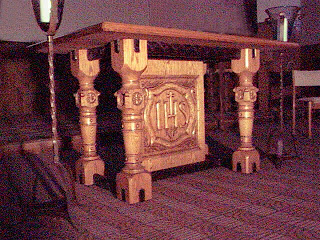 |
 So with the enthusiastic approval of then president Fr. Tim Shannon, S.J. the design for the furniture for the huge old chapel integrated African materials and motifs in the design of altar, ambo, and tables for the project.
So with the enthusiastic approval of then president Fr. Tim Shannon, S.J. the design for the furniture for the huge old chapel integrated African materials and motifs in the design of altar, ambo, and tables for the project.I wept to see the black dust of the wenge soaking into the pores of my white skin. I felt in the swelling of my muscles a mere whisper of the shouting exertion of the slaves whose progeny found ways of fitting into the structure of this school.
The results were quite beautiful. You can see the wenge pieces above as the structural crossmembers of this one of three credence tables, the crucifixion rose window of the chapel like a host raised above it.
The existing elements of design included the leg of a former baroque altar facade, the rose window above, and a Flint Faience tile pattern used throughout the buildings. The tile pattern depicted the insignia used by Ignatius of Loyola, the Jesuit founder, which had been used in various forms as the phonetic abbreviation of Jesus Christ.
A turned and carved leg was proposed that would echo the elements of the marble leg but be much more efficiently produced in the significant quantity required. Carved panels would replicate the Ignatian IHS, with the cross rising from the crossbar of the H and the three nails of the crucifixion below.
Fabrication of the legs involved gluing up stock to turn on the lathe, then carving the faces. Jigs were used to make the legs uniform and increase efficiency, but the sheer volume of parts made the production a litany-like process of repeating steps. The petals of the florettes in the legs, for example, yields this math: Two altars one for the Jesuit Residence chapel), three credence tables and the ambo required a total of 22 legs in 3 sizes. 22 legs=88 florettes. 88 florettes = 704 petals, each of which required 6 blows of the mallet on a chisel turned to a different angle after each three strokes - 4224 strokes!
 And add to that the four corners (times 88)of the "square circle" motif of the rose window within which those florettes are carved, and the other details of the legs, and you can see why I shake my head just looking at the photo of the parts that accumulated in my little basement shop down the street from the university campus, just two miles from the High School.
And add to that the four corners (times 88)of the "square circle" motif of the rose window within which those florettes are carved, and the other details of the legs, and you can see why I shake my head just looking at the photo of the parts that accumulated in my little basement shop down the street from the university campus, just two miles from the High School. The process of turning, carving, and joinery eventually yeilded to staining and a durable lacquer finish, and the pieces were put in place in the chapel. Here are a few photos.
One of my Jesuit friends, after returning to Detroit from abroad, said that he was shocked by the massiveness and detail of the pieces. They reminded him, he said, of what he would see in old churches in Europe. I smiled. But these, I thought to myself, are held together by African wood. But when I realized that he had just returned from building a school in Sudan, I told him the story of the wenge, and the integration of that ancient pattern from the Congo. And he smiled.









No comments:
Post a Comment